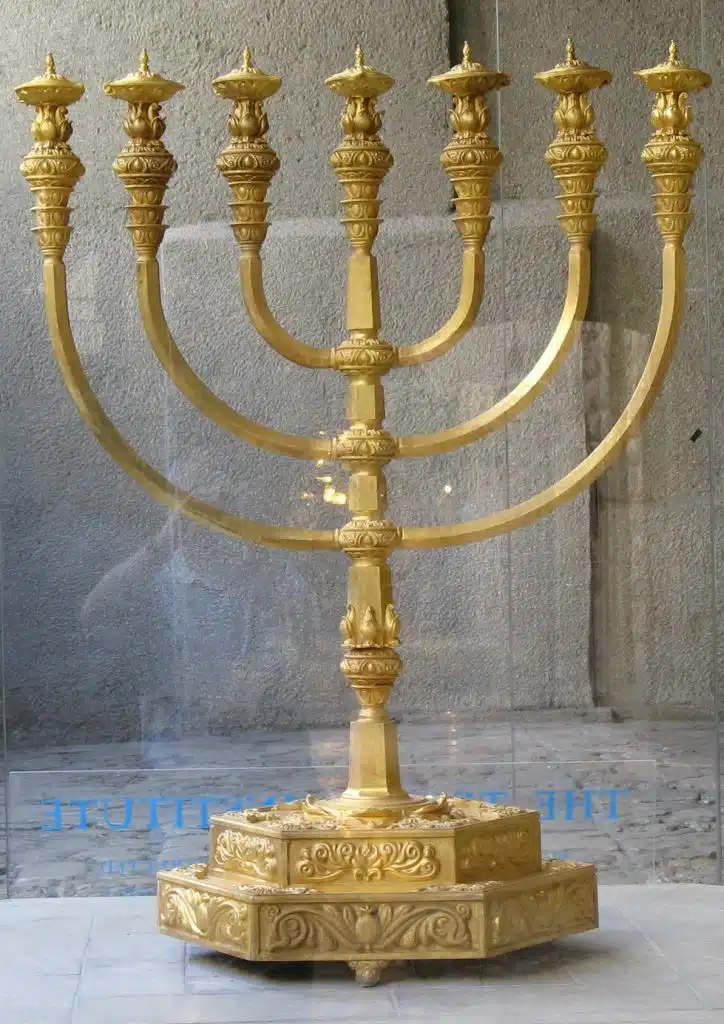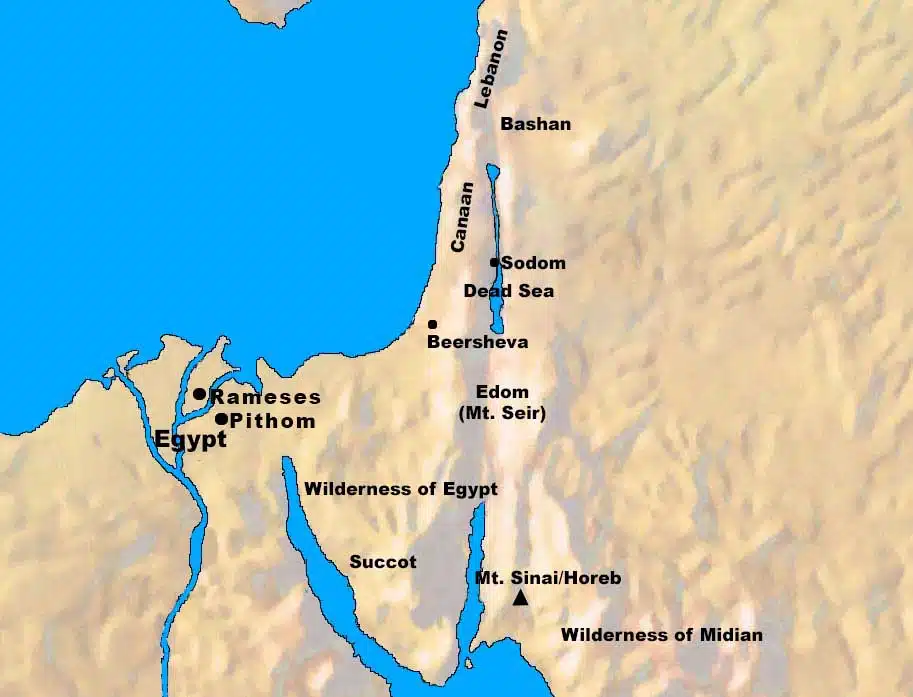The lampstand is constructed. The specifications for building these items were given in Exodus 25:31 – 40.
Verse 17 is a summary statement about the making of the next item—the lampstand of pure gold. It was placed in the tabernacle opposite the table of showbread (Exodus 26:35). The Hebrew word for lampstand is “menorah,” and it is a popular symbol of Judaism and Israel even today.
The lampstand was made of hammered work. The word for hammered work (Heb. “miqdash”) probably means gold that was hammered into shape to form an ornate work of art. The word is also used to describe the creation of the cherubim (Exodus 37:7 – 9) and two silver trumpets (Numbers 10:2).
The summary goes on to say that its base and its shaft; its cups, its bulbs and its flowers were of one piece with it. The cups and bulbs refer to decorative almond blossoms. Their construction is described in the next verses.
Bezalel, the chief craftsman, was to place six branches going out of its sides. He arranged three branches of the lampstand from the one side of it and three branches of the lampstand from the other side of it. So, there was a “center stem” plus six branches, three on either side of the center one. This makes a total of seven lamps, arranged in perfect symmetry. The number seven is often associated with completeness, as in seven days to create the heavens and earth. Revelation 4:5 speaks of the “seven Spirits of God” before His throne, which are represented by a seven-branched lamp. This again speaks to the assertion in Hebrews 9:23 that the tabernacle and its aspects represent true things in heaven. The number seven likely represents the comprehensive, eternal nature of God. God is complete in all respects: perfectly harmonized and lacking nothing.
Decorating each branch and the stem were three cups shaped like almond blossoms, a bulb and a flower in one branch, and three cups shaped like almond blossoms, a bulb and a flower in the other branch. The almond tree blossomed earlier than any other tree in the spring and thus symbolized vitality and fertility. God is the author and source of all that is productive and useful for humanity. The proper worship of God leads to productive and vigorous activity that creates usefulness and bounty for communities, and ultimately all humanity.
Elsewhere in Exodus, almond blossoms are significant. God validated Aaron’s authority by miraculously causing his walking stick to bloom with almond blossoms and ripe almonds (Exodus 17:8). Aaron’s rod was placed in the ark (Hebrews 9:4).
This design was done for the six branches going out of the lampstand (v. 19). There were six branches and one stem, each having a lamp. In summary, three cups, a bulb, and a flower were added to each of six branches. Seven lamps sitting on six branches and a stem could reflect the fullness of creation, with six days of work and one of rest making seven, fulfilling a week.
Next, in the lampstand there were four cups shaped like almond blossoms, its bulbs and its flowers (v. 20). Once again, the image of almond trees is used to decorate the lampstand. This added to its incredible beauty.
Also, a bulb was under the first pair of branches coming out of it, and a bulb under the second pair of branches coming out of it, and a bulb under the third pair of branches coming out of it, for the six branches coming out of the lampstand (v. 21).
In verse 22, the one-piece construction of the lampstand’s ornaments was stated. Here, it stated that their bulbs and their branches were of one piece with it; the whole of it was a single hammered work of pure gold. The lampstand was not a collection of individual objects bound together—it was made from a single piece of gold by expert craftsmen.
Additionally, Bezalel made its seven lamps with its snuffers and its trays of pure gold. Snuffers were tongs used to maintain the wicks of the candles.
Verse 24 summarizes the construction of the lampstand and its associated objects. Thus, Bezalel made it and all its utensils from a talent of pure gold. A talent is a unit of weight. It is thought to have been the equivalent to around seventy-five pounds (or 34 kilograms). This amount of gold would make a fairly large lampstand, though its exact size is not given. The Temple Institute reproduction on display in Jerusalem is roughly five feet tall, and was designed based on multiple considerations.

The practical purpose of the lampstand was to provide light for the priests to do their duties before the LORD. The priests were required to tend to the lampstand in the morning and at sunset (Exodus 27:20 – 21) to ensure that there was light in the tabernacle all the time. This might represent God’s abiding presence and unchanging truth, which is perpetual. The priests tending would include filling the lamps with olive oil, which was to be provided by the people (Exodus 27:20-21).
The lampstand was an image used in other places in Scripture. It was seen by Zechariah in a vision in Zechariah 4:2. In the New Testament, Jesus called Himself the “light of the world” in John 8:12, and the lampstand was a symbol of the church’s testimony to a dark world (Revelation 1:12, 2:1, 5). Jesus also said His disciples are to be the “light of the world” (Matthew 5:14). The lampstand’s light represents the testimony of God, and His truth shining through others.
Biblical Text
17 Then he made the lampstand of pure gold. He made the lampstand of hammered work, its base and its shaft; its cups, its bulbs and its flowers were of one piece with it. 18 There were six branches going out of its sides; three branches of the lampstand from the one side of it and three branches of the lampstand from the other side of it; 19 three cups shaped like almond blossoms, a bulb and a flower in one branch, and three cups shaped like almond blossoms, a bulb and a flower in the other branch—so for the six branches going out of the lampstand. 20 In the lampstand there were four cups shaped like almond blossoms, its bulbs and its flowers; 21 and a bulb was under the first pair of branches coming out of it, and a bulb under the second pair of branches coming out of it, and a bulb under the third pair of branches coming out of it, for the six branches coming out of the lampstand. 22 Their bulbs and their branches were of one piece with it; the whole of it was a single hammered work of pure gold. 23 He made its seven lamps with its snuffers and its trays of pure gold. 24 He made it and all its utensils from a talent of pure gold.
Check out our other commentaries:
-
2 Corinthians 1:8-11 meaning
Paul specifies that he and Timothy suffered persecution in the province of Asia, to the point where they thought they were going to die. But...... -
Matthew 3:3 meaning
Matthew points out that John the Baptizer is the fulfillment of the prophecy in Isaiah 40:3....... -
Matthew 5:21-22 meaning
Jesus says that righteousness is a matter of both outwardly following the Law and inwardly reflecting the spirit behind the law. Acting in violence and...... -
Exodus 30:7-10 meaning
The high priest was to burn incense every morning and evening, resulting in incense being before the LORD all day, every day. ...... -
Proverbs 1:10-15 meaning
The Wisdom of God is not the only voice vying for our perspective and trust. Sin calls us toward the path of foolishness, a perversion......



